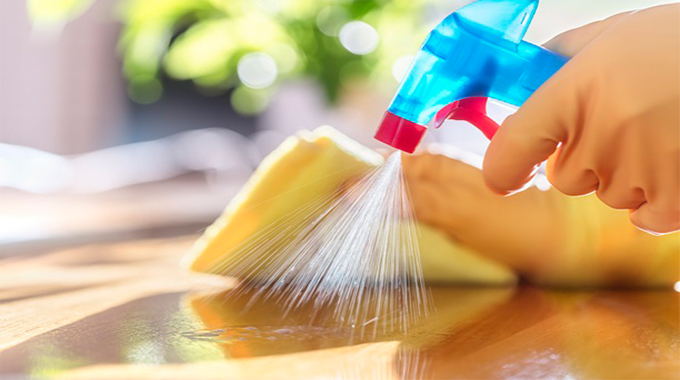Cleaning and disinfection against Covid-19

Dr Tatenda Simango
I HOPE you are well and in good spirits.
The past fortnight has seen a lot of institutions being closed down and have had to undergo deep/thorough cleaning to disinfect after a Covid-19 case has been diagnosed among staff or visitors to the organisation.
The idea has been to kill potential virus that would be lingering on the surfaces at the premise. The World Health Organisation (WHO) has set guidelines that will help institutions, cleaning companies and even homes taking care of Covid-19 patients tailor their own standard operating procedures.
One laboratory (controlled) study found that Covid-19 remains viable on:
• Cloth, cardboard and wood for one day,
• Glass for two days,
• Stainless steel, copper and plastic for four days,
• Medical mask outer surface for seven days.
The environmental cleaning techniques and cleaning principles should be followed as far as possible. Surfaces should always be cleaned with soap and water or a detergent to remove organic matter first, followed by disinfection. Therefore, chlorine or alcohol should be applied after cleaning to kill the remaining micro-organism.
Environmental surfaces include sinks, toilets, electronics, furniture, counter tops, stairway rails, floors, light switches and walls. These environmental settings need to be properly cleaned and disinfected to prevent further transmission. Washing of hands and avoiding touching of face remain the primary prevention approach in reducing the transmission associated with surface contamination. Particular attention should be paid to environmental cleaning of high-touch surfaces and items, such as light switches, bed rails, door handles, tables, water/beverage pitchers, trays, mobile cart rails and sinks, which should be performed frequently.
The number of cleaning staff should be planned to optimise cleaning practices.
Cleaning should progress from the least soiled to the most soiled areas, and from the higher to the lower levels so that debris may fall on the floor and is cleaned last in a systematic way to avoid missing areas. Use fresh clothes at the start of each cleaning routine. Discard clothes that are no-longer saturated with cleaning solution.
Detergent and disinfection become contaminated during cleaning and progressively less effective if the organic load is too high; therefore, the continued use of the same solution may transfer the micro-organisms to each subsequent surface. This makes it prudent to discard solution after each use in areas with Covid-19 patients. Use fresh solution for each day.
Cleaning equipment should be well maintained, colour coding of equipment used in isolation area for patients should be done and separated from other equipment. Buckets should be washed with detergent, rinsed, dried and stored inverted to drain fully when not in use.
Personnel preparing or using disinfectants in health care settings require specific personnel protective equipment (PPE), due to the high concentration of disinfectants used in these facilities and the longer exposure time to the disinfectants during the workday. Thus, PPE for preparing or using disinfectants in health care settings includes uniforms with long-sleeves, closed work shoes, gowns and/or impermeable aprons, rubber gloves, medical mask, and eye protection (preferably face shield).
Before using any chemical read, understand and follow the manufacturer instruction and manual specifications. Disinfectant solutions should always be prepared in well-ventilated areas. Avoid combining disinfectants, both during preparation and usage, as such mixtures cause respiratory irritation and can release potentially fatal gases, in particular when combined with hypochlorite solution.
Commonly used and effective disinfectants are:
• Ethanol 70-90 percent,
• Chlorine-based products (eg, hypochlorite) at 0,1 percent /0,5 percent; high concentrations of chlorine can lead to corrosion of metal and irritation of skin and mucous membranes, it can also trigger asthmatic attacks,
• Hydrogen peroxide > 0,5 percent,
• Ammonium.
Contact time of a minimum of 1 minute is recommended for these disinfectants or as recommended by the manufacturer.
INDOOR SPACES
Routine application of disinfectants to environmental surfaces by spraying /fogging/misting/fumigating is not recommended for Covid-19. Contaminants outside the direct spray zone are not destroyed. Spraying increases the risk of eye respiratory and skin irritation and the resulting health effects. Chemicals like formaldehyde, chlorine and ammonium compounds have adverse health effects when sprayed. Spraying environmental surfaces in both health-care and non-health care settings such as patient households with disinfectants may not be effective in removing organic material and may miss surfaces shielded by objects, folded fabrics or surfaces with intricate designs. If disinfectants are to be applied, this should be done with a cloth or wipe that has been soaked in disinfectant.
OUTDOOR SPACES
Spraying or fumigation of outdoor spaces, such as streets or marketplaces, is also not recommended to kill the Covid-19 virus or other pathogens because disinfectant is inactivated by dirt and debris and it is not feasible to manually clean and remove all organic matter from such spaces. Moreover, spraying porous surfaces, such as sidewalks and unpaved walkways, would be even less effective. Even in the absence of organic matter, chemical spraying is unlikely to adequately cover all surfaces for the duration of the required contact time needed to inactivate pathogens. Furthermore, streets and sidewalks are not considered to be reservoirs of infection for Covid-19. In addition, spraying disinfectants, even outdoors, can be harmful for human health.
INDIVIDUALS
Spraying individuals with disinfectants (such as in a tunnel, cabinet, or chamber) is not recommended under any circumstances. This could be physically and psychologically harmful and would not reduce an infected person’s ability to spread the virus through droplets or contact. Moreover, spraying individuals with chlorine and other toxic chemicals could result in eye and skin irritation, bronchospasm due to inhalation and gastrointestinal effects such as nausea and vomiting.
If using a no-touch disinfection technology, environmental surfaces must be cleaned manually first by brushing or scrubbing to remove organic matter. These technologies supplement but do not replace the need for manual cleaning procedures.
One of these devices that is being marketed uses Ultra Violet-irradiation, however, several factors may affect the efficacy of UV irradiation, including distance from the UV device; irradiation dose, wavelength and exposure time; lamp placement; lamp age; and duration of use. These factors may affect the efficacy of destroying Covid-19 from surfaces.
For details of the guideline look up Cleaning and Disinfection Of Environmental Surfaces In Context Of Covid-19 Interim Guidelines May 2020.
Dr T Simango can be contacted on [email protected] or follow him on Facebook@ 9th Avenue Surgery.










Comments